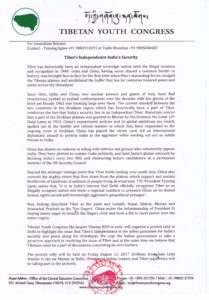Tibet’s Independence India’s Security
Tibet has historically been an independent sovereign nation until the illegal invasion and occupation in 1949. India and China, having never shared a common border in history, was brought face to face for the first time when Mao’s marauding forces ravaged the Tibetan plateau and annihilated the buffer that has for centuries fostered peace and amity across the Himalayas.
Since then, India and China, two nuclear powers and giants of Asia, have had treacherous eyeball to eyeball confrontations over the decades with the ghosts of the brief yet bloody 1962 war looming large over them. The current standoff between the two countries in the Droklam region which has historically been a part of Tibet, reinforces the fact that India’s security lies in an Independent Tibet. Historians concur that a part of the Droklam plateau was granted to Bhutan by His Holiness the Great 13th Dalai Lama in 1913. China’s expansionist policies and its global ambitions are clearly spelled out in the hostile and callous manner in which they have responded to the ongoing crisis in Droklam. China has played the victim card, led an international diplomatic assault to portray India as the aggressor while sending out not so subtle threats to India.
China has shown no remorse in siding with nations and groups who vehemently oppose India. They have plotted to contain India militarily and limit India’s global outreach by blocking India’s entry into NSG and obstructing India’s candidature as a permanent member of the UN Security Council.
Beyond the strategic vantage point that Tibet holds looking over south Asia, China also controls the mighty rivers that flow down from the plateau which support and sustain livelihoods of hundreds of millions of people living downstream. TYC President Tenzing Jigme states that, “it is in India’s interest that Delhi officially recognizes Tibet as an illegally occupied nation and leads a regional coalition to pressure China on its dismal human rights record and increasingly aggressive geopolitical presages”.
Mao Zedong described Tibet as the palm and Ladakh, Nepal, Sikkim, Bhutan and Arunachal Pradesh as the ‘five fingers’. China under the helmsmanship of President Xi Jinping seems eager to wrench the fingers close and form a fist to exert power over the entire region.
Tibetan Youth Congress, the largest Tibetan NGO in exile, will organize a protest rally in Delhi to highlight the issue that Tibet’s independence is the safest guarantee for India’s security and peace along the Himalayas. We urge the Indian government to take a proactive approach in resolving the issue of Tibet and at the same time we believe that Tibetans must be a part of discussions concerning its own borders.
The protest rally will be held on Friday August 11, 2017 10:00am from Ram Leila Maidan to Jan tar Mantar in Delhi. Prominent Indian leaders and Tibet supporters will be taking part in the protests.

